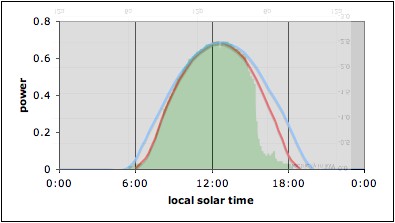The i v curve for a typical 12 volt pv solar panel is shown at fig 2 above this maximum power point in the example curve given above is where vmp is 17 volts and the current imp is 2 5 amps.
Solar panel output curve.
If you know the average daily peak sun hours for your location you can calculate the kwh your solar panels will make on a daily monthly and yearly basis.
A peak sun hour is the equivalent of the sun shining at an intensity for 1 000 kw per square meter for one hour expressed as 1 kwh m.
The output of a string of solar cells provides as much current as the worst performing cell piece each cell piece will have an output that falls along a distribution curve which pushes the total panel output lower 3.
Solar panel output is expressed in units of watts w and represents the panel s theoretical power production under ideal sunlight and temperature conditions.
Putting it all together.
On average a domestic solar panel has a power output of around 265 watts although it can range anywhere from as little as 225 watts to more than 350 watts.
The higher the wattage of a solar panel the more electricity it can produce under the same conditions.
Most home solar panels on the market today have power output ratings ranging from 250 to 400 watts with higher power ratings generally considered preferable to lower power ratings.
Therefore the rated or the maximum power wmax in watts is 17 volts times 2 5 amps or 42 5 watts.
Curved solar panels give up to four times more energy output.
The coating on the panel further lowers the output equipment needed for creating an iv curve.








